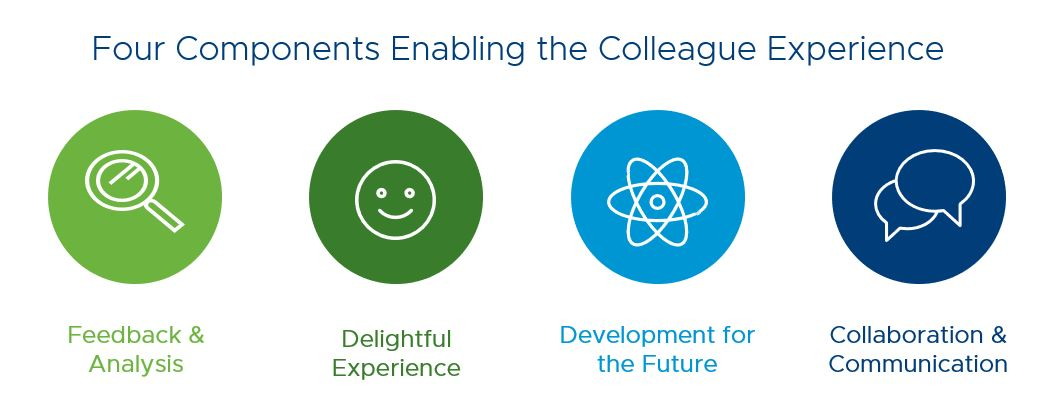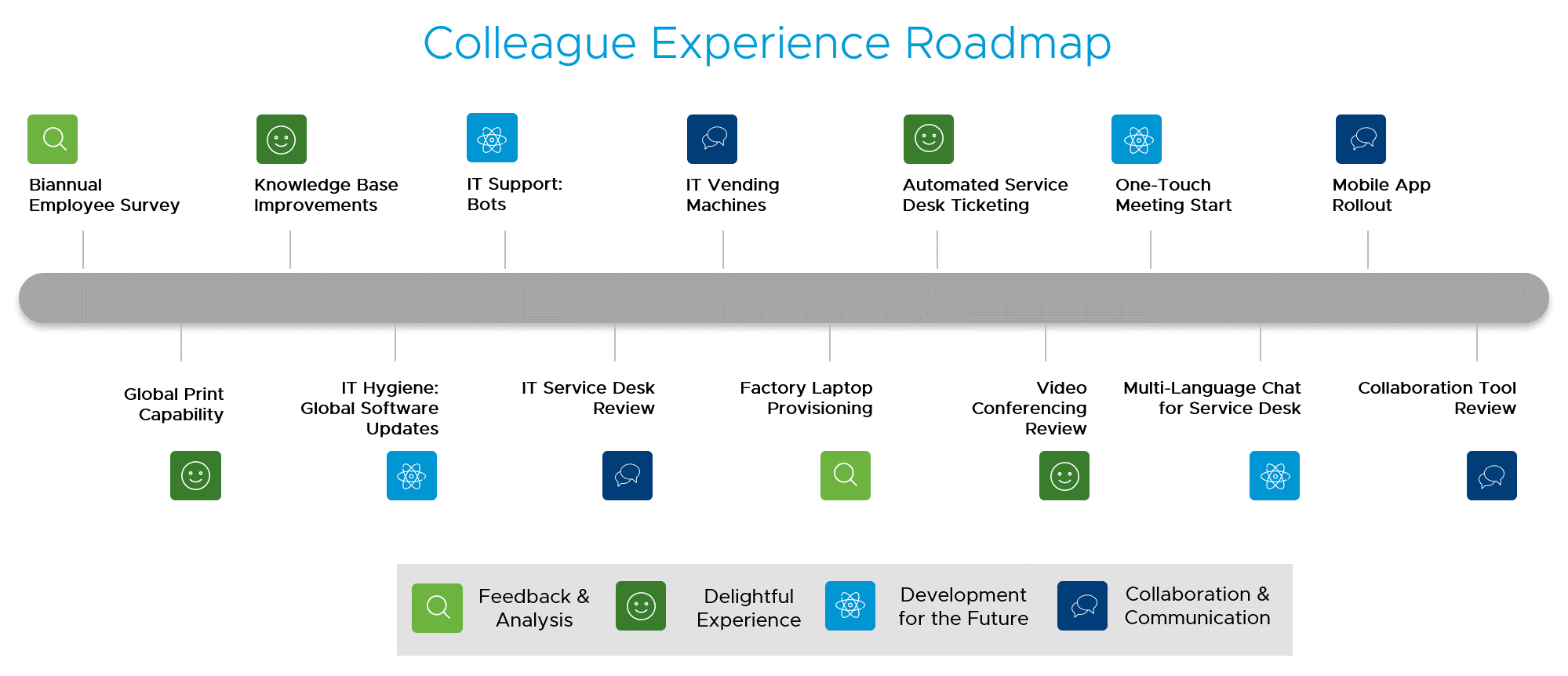by: VMware Chief Information Officer Jason Conyard

As IT leaders, we focus on the uptime of the network and mission-critical applications as key measures of IT success. We often overlook the role of the colleague experience as a driver in supporting the business, as productivity can be hard to quantify.
This view is rapidly changing as technology empowers organizations of any size to operate around the clock and around the world with unprecedented speed and scale. As mobile technology becomes a more integral part of our consumer world, the expectations for a similar look-and-feel are now pervading the enterprise.
As former VMware CIO Bask Iyer liked to say, every company is now a technology company. It then follows that how we deliver and support technology in the workplace will play a much bigger role in shaping our future success. The colleague experience may be even more important than ‘traditional’ hard costs.
Developing a Shared Vocabulary
Typically, when trying to justify an IT investment, we consider both hard and soft savings. The soft cost savings are dismissed or not taken seriously because they are not easily quantifiable.
In fact, investments in the colleague experience can deliver far greater benefits over time. The ease of use and intuitiveness of technologies can drive adoption because they improve how efficiently people can perform their jobs. The issue is that we don’t necessarily have the vocabulary or metrics to quantify the results in a way that gives them credibility in a business conversation. We can’t just say the circumstances will be better. IT should be able to articulate the advantages in corporate terms that a CIO or CFO can understand. More informed investment decisions can then be made that factor in productivity, retention, and risk.
Measuring Soft Costs: Several Perspectives
At VMware, capturing these metrics is a key component of any technology decisions. Kostadin Kushlev, VMware Senior Manager, Product Design, says even something as simple as a password reset can affect efficiency. VMware employees were periodically required to change their passwords. Then it would take some time for the password to propagate across IT’s systems. Even if we assume it took only an hour for the reset process, the impact was significant. Assuming 20,000 people work at an estimated $75/hour, the potential impact was $1.5 million in lost productivity. Now the password reset process takes five minutes.
These aren’t actual bottom-line savings. In reality, our colleagues can work on other projects while they are waiting so the lost time can be minimized. But this example illustrates how one change can have a significant impact on productivity and improve satisfaction.
Kushlev takes measuring success to a different level with a biannual survey where VMware employees provide feedback on issues ranging from technical support to hardware (laptop) and digital workspace satisfaction. The heart of the survey is the free text comments. His team uses natural language processing (NLP) to automate and segment comment analysis into something measurable. For example, the analysis found widespread frustration with a communications tool, an issue they quickly addressed and resolved. “We want our coworkers to see that we actively listen and act on their feedback,” said Kushlev. “IT decisions are based on quantifiable survey data.”
Robert Coggins, VMware Senior Manager, Authentication Services, adds that a process is now in place to fully provision Windows laptops at the factory and ship them directly to colleagues. “Usually it takes about 45 minutes to download everything to a new laptop,” says Coggins. “Now our people can be up and running in 15 minutes because the software is already on the device when it arrives.”
Time savings of 45 minutes per person doesn’t sound like a big deal. If you multiply that by 1,000 new devices over the next year, you get 45,000 minutes or 750 hours of time savings across the recipients of these devices. By eliminating the hours that people used to spend authenticating and downloading software when they received a new device, we can help them get to work faster and be more productive.
In addition, shipping time has been reduced by 75%, from an average of 30 days to 7 days. Faster delivery also translates to a faster time to productivity for the person receiving the new device. An added bonus: IT staff no longer have to configure new devices and can work on other things.
Also not to be overlooked are the advantages of these metrics to the company as a whole. Technology investments become more than out-of-pocket costs; they are evaluated for their contribution to fostering innovation and collaboration to our agility as a company. By providing a portfolio of software tools that colleagues are familiar with, VMware can also attract and keep the best talent. The need for shadow IT and its associated security risks are minimized because people don’t need to go around IT to get what they need.
Which goes back to the original question: How does IT quantify productivity gains and drains? In some cases, it’s straightforward: It takes 10 people 2 minutes less to do something. But how do we measure the impact of a 10-minute meeting delay because of conferencing technology issues? It’s difficult to measure the attendees’ state of mind once the meeting begins. Are they open and engaged or frustrated and annoyed? If they are not open, inclusive, and energized, the output from the meeting is compromised. If even 25% of meetings start like this, there is an impact because colleagues aren’t able to do their best work. And while these things are harder to measure, we can’t dismiss them. They are relevant to the success of the end work product.

Using a Roadmap
To better translate the time and cost savings into business terms, VMware IT has initiated a dedicated roadmap, much like the IT roadmaps we have for our cloud journey, application development, and other IT projects. The roadmap outlines the evolution of the colleague experience by breaking it down into categories, such as research, innovation, and collaboration.
Each IT team can see its contribution, then chart its progression. More importantly, by creating a timeline, goals, and measurements, we’ve taken the first step to create a shared vocabulary with our business counterparts. The result is more informed investment decisions that more heavily weigh the impact on efficiency and productivity. It also translates to higher job satisfaction and better retention rates.
Does your company have a colleague IT roadmap or is it something you are considering? Please join the discussion and share your thoughts on the challenges and successes you’ve had in measuring the colleague experience in your company. I will be discussing this topic with a panel at VMworld Europe session LDT1324, Increasing Productivity by Providing a Superior Employee Experience. To view a short video about the session, click here.
VMware on VMware blogs are written by IT subject matter experts sharing stories about our digital transformation using VMware products and services in a global production environment. Contact your sales rep or vmwonvmw@vmware.com to schedule a briefing on this topic. Visit the VMware on VMware microsite and follow us on Twitter.



